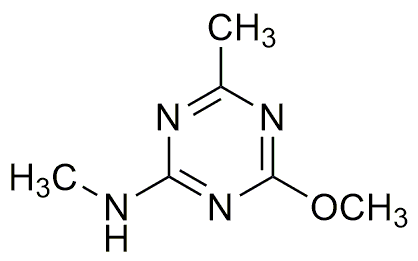2-Methoxy-4-methyl-6-(methylamino)-1,3,5-triazine is widely utilized in research focused on:
- Agricultural Chemicals: This compound serves as a key ingredient in herbicides, helping to control unwanted plant growth effectively while minimizing damage to crops.
- Pharmaceutical Development: It is explored for its potential in developing new medications, particularly in targeting specific biological pathways due to its unique chemical structure.
- Polymer Chemistry: The compound is used in the synthesis of specialty polymers, enhancing properties such as durability and resistance to environmental factors.
- Analytical Chemistry: It acts as a reagent in various analytical procedures, aiding in the detection and quantification of other compounds in complex mixtures.
- Biotechnology: Researchers utilize this chemical in the formulation of biocides, which are essential for maintaining sterile environments in laboratory settings.
General Information
Properties
Safety and Regulations
Applications
2-Methoxy-4-methyl-6-(methylamino)-1,3,5-triazine is widely utilized in research focused on:
- Agricultural Chemicals: This compound serves as a key ingredient in herbicides, helping to control unwanted plant growth effectively while minimizing damage to crops.
- Pharmaceutical Development: It is explored for its potential in developing new medications, particularly in targeting specific biological pathways due to its unique chemical structure.
- Polymer Chemistry: The compound is used in the synthesis of specialty polymers, enhancing properties such as durability and resistance to environmental factors.
- Analytical Chemistry: It acts as a reagent in various analytical procedures, aiding in the detection and quantification of other compounds in complex mixtures.
- Biotechnology: Researchers utilize this chemical in the formulation of biocides, which are essential for maintaining sterile environments in laboratory settings.
Documents
Safety Data Sheets (SDS)
The SDS provides comprehensive safety information on handling, storage, and disposal of the product.
Product Specification (PS)
The PS provides a comprehensive breakdown of the product’s properties, including chemical composition, physical state, purity, and storage requirements. It also details acceptable quality ranges and the product's intended applications.
Certificates of Analysis (COA)
Search for Certificates of Analysis (COA) by entering the products Lot Number. Lot and Batch Numbers can be found on a product’s label following the words ‘Lot’ or ‘Batch’.
*Catalog Number
*Lot Number
Certificates Of Origin (COO)
This COO confirms the country where the product was manufactured, and also details the materials and components used in it and whether it is derived from natural, synthetic, or other specific sources. This certificate may be required for customs, trade, and regulatory compliance.
*Catalog Number
*Lot Number
Safety Data Sheets (SDS)
The SDS provides comprehensive safety information on handling, storage, and disposal of the product.
DownloadProduct Specification (PS)
The PS provides a comprehensive breakdown of the product’s properties, including chemical composition, physical state, purity, and storage requirements. It also details acceptable quality ranges and the product's intended applications.
DownloadCertificates of Analysis (COA)
Search for Certificates of Analysis (COA) by entering the products Lot Number. Lot and Batch Numbers can be found on a product’s label following the words ‘Lot’ or ‘Batch’.
*Catalog Number
*Lot Number
Certificates Of Origin (COO)
This COO confirms the country where the product was manufactured, and also details the materials and components used in it and whether it is derived from natural, synthetic, or other specific sources. This certificate may be required for customs, trade, and regulatory compliance.


